
There are thousands of species of plants and they all have their own needs for sun, soil, and water. Different parts of your yard drain at different rates and a plant in a container will need more water than one in the ground. Because of that, we can’t prescribe specific watering schedules or amounts for your plants. Instead, there are some basic principles you can follow to help become a watering expert. Here are our do’s and don’t’s:
Do: Water new plants regularly in absence of rain.
Your plant is home and in the ground. It looks great, but a move can be disorienting–even if you’re a plant. The plant’s roots have been disrupted and it is planted in unfamiliar, sometimes less friendly, soil. It can only access water in the place that its roots can reach so it is at a disadvantage compared to its more established neighbors. If there is no rain, you need to water your new plant. Plan on watering, or at least checking on the watering needs, every day in the absence of rain for the first few weeks after planting. You may need to water twice a day in especially hot weather or if your plant is in a container. If there is rain, check the soil before uncoiling that hose to make sure you aren’t overwatering.
Don’t: Rely on a sprinkler system to properly water your plants.
Think of it this way: if sprinkler systems were the best way to water your plants, we wouldn’t spend hours every day at Colonial watering them by hand. We actually did have a sprinkler system in the 90s and it resulted in unevenly watered plants and a lot of wasted water. Sprinkler systems are not reliable sources of water for your plants. They do not target the roots and they do not differentiate between plants based on their needs, but based on their position in relation to the sprinkler. Yes, hand-watering is more work, but the results are worth it!
Do: Water in the morning.
Brew up some coffee and unroll the hose; it’s time to water. Watering in the morning gives the plants a chance to drink before the heat of the day. Watering during the heat of the day can waste water–losing it to evaporation. Water that sits on the foliage can burn the leaves in the hot sun. Watering at night is the second best choice, although the cooler temps with additional moisture can foster the growth of mildew. On the hottest of days, recheck your plants to see if they need a second night drink, but plan on starting the day with a hose or watering can in hand.

Don’t: Mist your plants.
There are very few plants that benefit from misting and most outdoor plants will actually fare worse if misted. The roots need the water, not the leaves. In fact, water on the leaves during the heat of summer can result in scorch, damaging the leaves of your plant and impacting its health. Instead, water at the base of the plant, near the root ball. That goes for your indoor plants too! Studies have shown that misting only increases the humidity near your plant temporarily. If you enjoy misting your indoor plants, have at it! Just don’t use misting as a substitute for proper watering.
Do: Water deeply.
This is true for both outdoor and indoor plants: less frequent but deeper watering is better than more frequent small drinks. Water at the base of the plant and water deeply to help promote the growth of roots downward. Stronger roots deeper in the soil will eventually access water deeper in the soil, making the plant more self-sufficient. This also reduces that amount of water that evaporates before it reaches the plants’ roots.
Don’t: Ignore the reaction of your plant.
Plants can’t tell you if they need water–but they can often show you. Keep an eye out for wilting plants, limp flowers, or crispy leaves, which are typically a sign of underwatering. Likewise, keep an eye out for limp or yellowing leaves, which can be a sign of overwatering. These signs of distress can sometimes look similar. If you’re unsure whether the plant is too dry or too wet, stick your finger down into the soil to see if the soil is dry or wet. When in doubt, you can always bring in pictures to help us diagnose your plant and help you right your watering course.
Do: Water containers more frequently than plants in the ground.
Plants in the ground grow to access water trapped deeper in the soil, which means that they can take advantage of rainfall from days before. Your containers are confined to the soil within the pot, which is not only limited, but also prone to greater temperature fluctuations and evaporation than the soil in the ground. Monitor your containers more closely to ensure they are consistently watered. Consistent watering is the key to healthy plants and consistent, plentiful harvests from fruit and veggie plants.
Summary: The best way to water is to water deeply in the morning at the base of your plants. Keep an eye out on how your plant reacts to your watering schedule and adjust your watering accordingly. Don’t treat all your plants the same: pay special attention to plants in containers, new transplants, and fruiting plants. Watering is a skill, but it can be learned by anyone who takes time to learn their plants’ signals and use these principles.
Colonial Gardens is an independent garden center located in Phoenixville in Chester County, Pennsylvania since 1967. We carry one of the widest selection of annuals, perennials, trees and shrubs, and food gardening crops in Southeastern Pennsylvania. We offer professional landscaping services and a full-service florist. Visit our greenhouse for unique houseplants and our gift shop for gifts and garden accessories. In the fall and winter, join us for our family-friendly seasonal events and Christmas shop.
